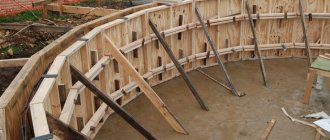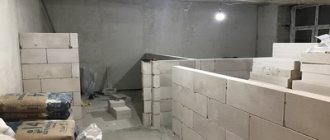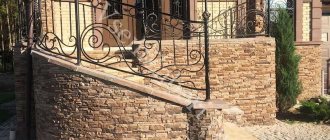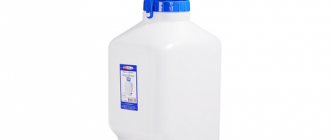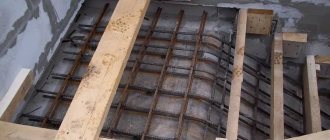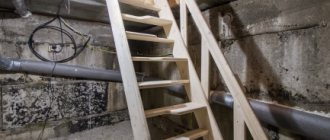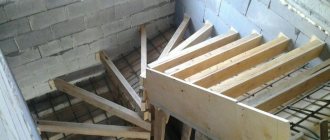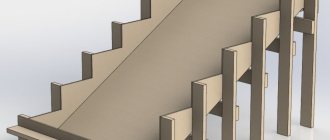The size of the concrete block depends on the scope of its application. The products are used for the construction of supporting structures, walls, ceilings, and staircases. Such artificial building materials are available in any color, and the shapes from them are used to build small and medium-sized houses in a very short time. If according to the plan a house is built from wood, then concrete blocks will be used to build the basement. Also, such reliable building material is used for the construction of houses, hangars, saunas, garages, non-residential buildings and fences. Due to its reasonable price, the product is popular and has improved sound insulation and heat insulation qualities.
Types of blocks
Concrete blocks have differences in shapes, parameters and fillers. Products are made from light or heavy type concrete solutions.
Heavy
The building material belongs to the heavy variety when its dry mixture density is up to 2500 kg/m3. The main types of concrete blocks are made from heavy concrete, the main ones being sand-cement mortar and cinder block.
Sand-concrete
This type refers to hollow products that are reinforced with iron rods. The material is highly durable and is used for the construction of one-story buildings. For the construction of residential buildings, it is better to take the M 100 brand of concrete products. The blocks are available in two types:
- solid products are used for the construction of monolithic foundations;
- hollow elements are used to build walls.
Cinder concrete
The building material has low thermal insulation characteristics; for this reason, buildings made from them require additional insulation. Walls of load-bearing and internal types are built from cinder blocks.
Reinforced concrete blocks
This type of model, made of concrete mortar, has a rectangular shape, equipped with grooves that are designed for laying the mixture in the joint areas. The element has reinforcement built into it, which increases resistance to compression and expansion due to temperature changes. The building material is intended for building a foundation on different types of soil.
Lungs
Building materials with a density that reaches less than 1800 kg/cm3 are classified as lightweight concrete. The weight of the products is reduced due to the lightweight component included in the composition or the foaming of the binder solution artificially. The type of lightweight products includes expanded clay concrete, foam concrete and aerated concrete blocks.
Expanded clay concrete
This material is environmentally friendly; it is made with the addition of expanded clay, water and cement. The main features of expanded clay concrete are good sound insulation, the structure of the products is capable of allowing air to pass through. And at the same time, the building blocks have high thermal insulation qualities.
Aerated concrete
Blocks are a type of porous material; during their production, lime, quartz sand and a gas-forming agent for the cement composition - aluminum powder - are added to the mixture. Aerated blocks have a cellular structure on the surface and inside.
Foam concrete
The composition of the foam block includes sand, cement, water and a foaming agent. This building material is suitable for external and internal walls.
Why is it necessary to know the mass of FBS blocks?
The state standard GOST 13579-78 standardizes not only the strength characteristics of reinforced concrete products, but also establishes overall dimensions and weight. Why do you need to know how much a foundation block weighs? This is necessary to control the quality of products. In construction conditions at a site, it is impossible to determine the density of concrete, and weight is precisely the indicator that indicates this value.
Knowing how much an FBS block weighs and how many such blocks will be needed to build a foundation or for another construction purpose, you can choose the right special equipment for transporting, loading and unloading structures, and laying them. Such blocks are supplied in 10 and 20 ton equipment.
And if you have information about the mass of FBS blocks, you can save a significant amount of money on transporting bulky sections.
It is important to take into account downtime and unforeseen situations during the delivery of cargo to the site.
The enormous weight of FBS blocks is their disadvantage, but it plays an important role in the construction process, since it affects the quality and strength of the foundation, determines the reliability of the structure and ensures a long service life.
More on this topic on our website:
- How to lay FBS blocks with your own hands Foundation blocks for manual masonry are produced using vibration pressing technology in specialized factories. In order to understand how to lay foundation blocks, you need to determine the blocks...
- GOST for foundation blocks FBS The basis of any construction is its foundation, the reliability of which determines how long the building will last and will not disturb you. In the construction of houses, whether one-story or...
- Using used foundation blocks to build a retaining wall Retaining walls are erected to prevent the earth from sliding in places where there is difficult terrain. Their main purpose is to withstand the weight of the earth or buildings located...
- Construction of a prefabricated foundation from FBS blocks A solid foundation of any structure is the key to its durability and strength. This can be called a prefabricated foundation made of FBS blocks. It is the same tape...
Types of foundation blocks
Types of panels are distinguished by shape, presence of reinforcing elements, and classification of concrete. Quality characteristics depend on the production method, brand and strength. The main features are indicated by markings:
- FBS is a solid unreinforced panel intended for load-bearing structures, the foundations of multi-story buildings, and the construction of basement walls. The concrete block has a length from 88 cm to 118 cm, the width of the concrete block is 58 cm, and the height is from 30-40 cm.
- FBP are hollow blocks that are used as permanent formwork in the construction of basements and industrial buildings. The technique requires reinforcement followed by concreting;
- F – elements made of reinforced concrete (with reinforcement);
- FL – products for the construction of strip foundations;
- BF – blocks containing heavy concrete;
- FBV are solid slabs with longitudinal recesses that are suitable for laying communication systems and jumpers.
Standard weight
The weight of foam concrete directly depends on its density and size; the larger the dimensions and volume of the porous cells, expressed as a percentage, the greater the weight.
For each type of foam blocks, there are special calculation tables that consistently indicate size, density and weight. The basic values are valid under the condition of a total air humidity of 75%.
For specialists, the parameters of building elements made of lightweight porous concrete speak volumes. Depending on the parameters they are classified into:
- Thermal insulation;
- Thermal insulation and structural;
- Structural.
The standard weight of a 600x300x200 foam block under normal humidity conditions will be 23.3 kg.
It should be noted that maintaining exact geometry is impossible, so the weight and dimensions vary among different manufacturers.
Dimensions of blocks for foundations
Models where the height of the concrete block is 58 or 28 cm are popular. The width can be different - 30, 40, 50, 60 cm. There are three types of panels with this length:
- Additional block - 8 or 9 markings, it is used in order not to cut the whole element, the length is 78, 88 cm.
- 12 mark has a length of 118 cm and weighs from 264 to 960 kg.
- 24 brand – 238 cm length, weight 490-1960 kg.
The standard dimensions of FBS-4 are 40x20x20 cm, weight is 310 kg.
If other parameters are required, it is recommended to purchase models for laying the foundation, the length, width, and height of which may differ from those listed above. The marking serves as a length guide, for example 28 cm - 3, 38 cm - 4, 48 cm - 5, 58 cm - 6; 178 cm – 18 and height 38 cm – 4, 48 cm – 5.
Scope of their application
- Construction of the foundation.
This comes straight from the name - the blocks themselves were created solely to become a support for the house. - Construction of simple buildings.
Foundation blocks are good for building a barn or industrial building in the shortest possible time. They do not allow moisture to pass through, do not require additional maintenance and are very easy to use during the construction phase. Of course, the aesthetic qualities of the building will not be very high, but you can always paint it a cheerful red color. - Construction of fences.
Suitable for high security facilities or for those who value their privacy most. Such a fence, like buildings, will not be very aesthetically pleasing, but it will be extremely practical - easy to build, difficult to destroy, no holes and, if you have imagination (or barbed wire), great difficulty in climbing over. - Covering basement walls.
In the basement, the walls of which are made of foundation blocks, it will always be cool and never wet. In such a dry, cold place you can perfectly store any pickles.
Calculate yourself
In independently calculating the number of required blocks, knowledge of geometry is used: you need to divide the total volume of the intended foundation by the volume of 1 selected block. But not everything is so simple - the soil base must withstand the construction.
Let's consider the sequence of calculations using the following example:
- The weight of the future building (external and internal walls, floors, roof, equipment and furniture) will approximately be no more than 12,000 kg.
- For the construction of columnar foundation supports, we choose FBS 2-2-4-t. 17 support points with a total area of 6,800 cm² (2 dm x 2 dm x 17 pcs) will be required. With a height of 2 blocks, you will need 34 pieces with a total weight of 30 kg x 34 = 1,020 kg.
- The total weight of the building with the foundation is correspondingly equal to 13,020 kg. We calculate the load per 1 cm² of soil: 13,020 / 6,800 = 1.915 kg/cm².
Solution: if the bearing capacity of the soil at the construction site is 2 kg/cm² or higher, then the foundation is chosen correctly, otherwise the total supporting area of the foundation blocks (number of points or brand) will have to be changed upward.
The fundamental collection that guides the correct laying of the foundation is SP 22.13330.2011, as well as the updated version of SNiP 2.02.01-83.
In areas with soils that have weak characteristics, the weight distribution area of the house can be increased by creating a special cushion for FBS. It can be arranged in several ways:
- A layer of the calculated thickness, expanding towards the bottom at an angle of 35° (on each side), is poured from sand of the middle fraction. The depth of the backfill is determined as follows: the blocks have a width of 3 dm, the thickness of the sand is 0.2 m, then the size of the load transfer along the bottom of the cushion for the foundation being constructed, taken into account in the calculations, will be 0.63 m.
- Lean concrete with reinforcement. The sole is made slightly wider than the block and performs a double function: it distributes the weight and prevents deformation of the overall structure due to different settlements of the elements.
- Pre-fabricated concrete products.
Independently making a solid foundation for subsequent installation of vertical walls from foundation blocks of lighter weight in the form of a prefabricated strip will not require a significant increase in material consumption, but will increase the stability and strength of the building’s foundation throughout the entire period of its operation.
An example of preparing the sole for laying FBS is visible in this photo.
During the installation process, the blocks are laid on ready-made concrete or self-prepared cement-sand mortar. Vertical joints are also filled with mortar. To lay FBS, you need a truck crane and a team of 5 or more people (slinging and mortar work).
In the practical implementation of calculations, it must be taken into account that the thickness of the seam between the rows of foundation blocks is up to 40 mm. When drawing up a project, the length and height of the blocks, for convenience, are taken 20 mm larger than the actual one, and the joints between the elements are indicated by a line.
Solid foundation block
FBS 24.4.6-T is the most commonly used high-strength block-type building material. FBS is a rectangular solid block for general purpose. Classic FBS 24.4.6.T is made from traditional material - heavy concrete with an average density of at least 2300 kg/m3. FBS concrete blocks are intended for the construction of foundations of low-rise buildings and the construction of basements of various depths, as well as technical underground premises of any buildings. FBS is also often used for the construction of walls of unheated buildings and industrial structures. Concrete blocks of this type are often used in road construction as barriers, in industrial construction
Product marking
The following symbol
FBS foundation blocks:
Designation of the type of foundation block, rounded values of the length, width, height of the reinforced concrete product, then the type of concrete is indicated.
- FBS – solid foundation block;
- the first digit is the length;
- the second is the width;
- third - height;
- T - made of heavy concrete.
Marking marks, date of manufacture and weight of products must be on the side edge of each block.
Product characteristics
FBS 24.4.6-T blocks are the main material for a strip foundation (a strip of reinforced concrete along the perimeter of the entire building including the center lines). Most often, strip foundations made from FBS blocks are used in highly heaving and moisture-saturated soils. The blocks have low water absorption and resist the destructive effects of groundwater for a long time.
As mentioned above, the classic FBS 24.4.6.T block is made of heavy concrete. Such blocks are suitable in cases where they will be forced to withstand high loads from the walls of the building. The qualities of strength, reliability, and corrosion resistance of heavy concrete are unrivaled. Deformation characteristics and resistance to moisture allow FBS blocks to become an ideal material for basement walls and other technical underground objects. A block of heavy concrete does not crumble, does not rot, does not age, does not emit toxic substances
FBS have the shape of a monolithic rectangular parallelepiped, 2380 mm long, 400 mm wide and 580 mm high. The mass of FBS made of heavy concrete is much greater than that of expanded clay concrete and other materials, and amounts to 1300 kg. But the solid mass is determined by the durability, strength and stability of heavy concrete blocks.
Such blocks can be used if the calculated seismicity of the object is no more than 8 points. For light, non-buried strip foundations, blocks with a width of 400 mm are used; for more powerful and critical foundations, for load-bearing walls of basements and ground floors, blocks with a width of 500 mm and 600 mm are used. For non-load-bearing basement walls, blocks with a width of 400 mm and 300 mm are used.
Reinforcement of the FBS block is carried out in rare cases, because thanks to the material and design, they do not require steel rods to be inserted into the structure.
The versatility of FBS 24.4.6-T blocks lies not only in the variety of shapes and sizes that allow the implementation of any engineering solution, but also in the fact that the blocks can be used in various climatic conditions and on any soil. FBS blocks are one of the few reinforced concrete products that can withstand a very wide temperature range - from +50 to -70 C.
The production of fundamental concrete blocks is carried out in steaming chambers, both outdoors and indoors.
The main requirements for FBS are the guarantee of their special strength, as well as compression resistance, since the main purpose of foundation blocks is to withstand the colossal loads of the structure. When used in the production of high-quality concrete, foundation blocks are not subject to deformation, and are also characterized by increased frost resistance and water resistance, and are resistant to aggressive environments. All these qualities significantly expand the scope of application of FBS.
Product marking
Markings on FBS foundation blocks must be applied to the side surface of the block.
a technical passport is issued by the manufacturer
, where the following parameters are specified:
- grade of concrete for frost resistance and water resistance;.
- concrete grade in terms of strength and its average density;
- tempering strength of concrete and actual tempering density of concrete;
- date of manufacture;
- number of reinforced concrete products;
- indication of compliance with the state standard.
- tempering strength of concrete and actual tempering density.
Product quality control
Even at the manufacturing plant of concrete foundation blocks, they undergo strict quality control, one of the stages of which is checking for geometric deviations. Deviations in the dimensions of foundation blocks should not exceed the following indicators: in length + 13 mm, in width and height ±8 mm, in cutout dimensions ±5 mm, and deviations from the straightness of the profile of the surfaces of the foundation block should not be more than 3 mm over the entire length and width block.
Cracks are not allowed in the concrete from which the blocks for basement walls are made, with the exception of local surface shrinkage cracks. And their width should not be more than 0.1 mm (for blocks made of heavy and dense silicate concrete) and 0.2 mm (for FBS blocks made of expanded clay concrete). The FBS 24.4.6-T block can have several types of concrete surface - for painting, finishing with ceramic tiles and unfinished non-facial surfaces.
Installation
Installation of FBS foundation blocks can take place at the construction site if the necessary mechanisms are available for this. Mounting loops made of smooth rod reinforcement can be installed at a distance of 300 mm from the ends of the block, flush with its upper surface (in FBS type blocks with a length of 1180 and 2380 mm). If special gripping devices will be used when installing foundation blocks, then, by agreement between the manufacturer and the consumer, it is possible to produce blocks without mounting loops at all. Also, the mounting loops of the FBS concrete block must be cleared of concrete deposits, otherwise this can significantly complicate the installation process.
Storage and transportation
FBS blocks are strongly recommended to be stored in stacks that are sorted by brand and batch and tightly stacked with each other. In this case, the height of one stack of foundation blocks should not exceed 2.5 meters. Pads for the bottom row of FBS 24.4.6.T blocks (at least 30 mm thick) must lie on a dense, carefully leveled base.
Transportation of foundation blocks is only possible if they are securely secured in order to prevent their mixing and possible damage. The number of blocks during transportation depends on the carrying capacity of the vehicle. The height of the stack of FBS blocks is set depending on the load capacity and dimensions of the transport used.
When choosing a material for building a house, you should focus not only on cost, but also on the characteristics that determine its quality: weight, density, frost resistance and water absorption.
The weight of any material, including the weight of a foam block 600x300x200, depends on the fillers. Concrete blocks come in different types and have their own characteristics.
Consequences of incorrect parameter definition
If you purchased FBS stones that are lighter than required by GOST, then in this case there were gross violations in the production process; in fact, this is a defect and it will be difficult to predict how it will behave as a foundation.
It is better not to buy such blocks, especially for multi-storey buildings.
Determining the dimensions of the foundation and its weight forms the basis for calculating the load that it is capable of carrying during operation. Taking it as a basis, the loads of the weight of the structure, snow and wind influence and additional operating pressure are determined.
If the load-bearing properties of a foundation made of “lightweight” FBS are weakened, then naturally it will not be able to support all of the above loads - the structure will collapse.
For high-rise buildings, at the design stage, not only the brand of concrete blocks is indicated, but also their manufacturer. In addition, during the construction process, the developer must organize high-quality technical control over the compliance of purchased building materials with certificates, design and GOST requirements.
Technical characteristics of building blocks
When choosing building blocks, you need to focus on the following parameters:
- Durability . This indicator is indicated in the grade of the material. Unit of measurement – kg/cm2. It characterizes the loads under which the block is deformed (cracks form, geometry is disrupted).
- Thermal conductivity . It is calculated from 0 and shows how much heat a wall with an area of 1 m2 will transmit when the temperature fluctuates by 10C. The higher this indicator, the less heat the room will retain.
- Density _ This parameter is responsible for the dimensions and weight of the building block. Denoted by the letter D, measured in kg/m3. The strength of the future building and its thermal conductivity directly depend on it.
- Frost resistance . This characteristic is designated by the letter F (for example, F15, F25, etc.), and indicates the number of cycles after which the material will begin to deform and collapse. In Russia, 1 cycle is equal to 1 year, during which the material loses 10% of its strength. Frost resistance can be increased by cladding or finishing the walls.
- Shrinkage . A value indicated as a percentage and characterizing the degree of reduction of the block after completion of construction. This phenomenon is most typical for aerated concrete blocks, and least typical for ceramic and expanded clay concrete blocks.
- Moisture absorption . This parameter shows the amount of moisture that the material can absorb. For almost all building blocks, this parameter is low, so after the construction of the building, finishing of the facade will be required.
How to understand blocks
Foundation blocks are monolithic concrete parallelepipeds, which are used for mounting vertical walls of a strip base or individual supports for light frame houses and log houses.
According to their intended purpose, the elements are used for the construction of basement wall structures, laying in recessed basement foundations, and are divided into 3 types:
- solid;
- solid with a cutout (for the possibility of laying jumpers or passing communications);
- hollow (FBP with open voids on the bottom side).
At the side ends of such a product there are grooves for filling with a binder solution to ensure the connection of the blocks in one row with each other.
There are 2 mounting loops on top for installation using slings with hooks. The overall monolith mass can be reinforced to enhance the load-bearing capacity (must be indicated in the project).
An example of what FBS blocks look like is shown in this photo:
The materials for production are heavy, expanded clay and silicate dense grades of concrete.
In construction, for the installation of reliable foundations, a product line of solid foundation blocks FBS made of heavy concrete is used. Expanded clay concrete FBS (porous fillers made of baked clay), blocks of dense silicate concrete, FBV, FBP are described in detail in GOST 13579-78* as materials for constructing basement walls.
Characteristics
There is no special need to calculate the weight of a standard foundation block - the products are produced strictly according to technology in forms of the established size from M100 or M200 concrete. The solution is compacted by mandatory vibrocompression; the resulting blanks are steamed in special chambers for a certain time, so they have almost the same density and volume.
Based on these manufacturing conditions, the weight of foundation blocks of a certain brand is contained in the reference table:
The product brand contains all the necessary information so that you can determine how much the desired foundation block weighs, knowing the weight of 1 m³ of concrete from which it is made.
The abbreviation denoting the brand indicates all sizes of FBS in dm.
For example, FBS 24-4-6-t designates products 240 cm long, 40 cm wide, 60 cm high. The letter designations at the end have the following meaning:
- T – heavy concrete on crushed stone;
- L – lightweight concrete;
- P – the filler is expanded clay;
- C – silicate solution.
The construction of a foundation from ready-made FBS with the correct design justification, based on the geological conditions of the site, reduces the time of work (in relation to the required period for gaining strength of the concrete monolith) and the cost of this part of the building.
You can hear from an expert in this video why you need to be able to at least roughly calculate a rational version of a foundation made of FBS blocks for your own home:
Main characteristics
The production of FBS is carried out using various concrete mixtures:
| Concrete mix | Density |
| expanded clay | 1800 kg/cub.m |
| silicate | 2000 kg/cub.m |
| heavy | 2400 kg/cub.m |
Compressive strength depends on the grade of concrete. Minimum – B3.5. The highest indicator is B15. More often than others, FBS with strength B7.5 (M100 concrete) and B12.5 (M150) is used. The average compressive strength of finished structures is 100–200 kgf/sq.cm.
Other important characteristics
Withstands 50 freeze/thaw cycles
Water resistance class no less than W2
Specific gravity not higher than 2400 kg/cub.m
FBS is characterized by high strength and durability.
Certain types of FBS are produced with a surface that provides for the fastening of decorative materials, such as tiles. Cracks are allowed on blocks, the width of which does not exceed 0.1 mm (for expanded clay concrete elements - 0.2 mm).
Advantages and disadvantages of blocks
Pros of FBS:
- Rapidity.
Firstly, you don’t need to tinker with concrete, dilute it and mix it, which is difficult in itself for an unprepared person. Secondly, construction. Building something with blocks is like playing with a construction set, it doesn’t take much time and doesn’t require much effort. - Convenience.
The FBS design includes special hook couplings that allow them to be connected to each other in the simplest way. At the same time, it is also reliable - the blocks will not come apart once connected. - Fortress.
As a rule, FBS is made from good concrete, which is resistant to mechanical stress. It is not so easy to break through, and even constant pressure from the earth is not able to have any noticeable effect on it. In addition, the block design may include special grooves that can be used to further strengthen the foundation. - Heat resistance and oxidation resistance.
Concrete blocks do not enter into chemical reactions and will not mold or crumble over time. It is also not afraid of frost or extreme heat - when warming up or cooling down, it does not change its own characteristics too much.
Cons of FBS:
- Expensive.
The blocks themselves will cost a pretty penny - after all, to build a foundation you need more than one, or two. You will also have to pay extra for special equipment, which, although it will quickly and easily lay the blocks as needed, still costs money. - Unpredictability.
If among the blocks there is a poor quality one or an error is made in laying, the entire structure (after all, it is interlocked and monolithic) may become warped and quickly collapse - then everything will have to be redone, just as if the calculation for the soil was in vain and it still cannot hold the entire weight of the blocks.
Pros of FBV:
In addition to the heat resistance, strength, speed of construction, convenience and resistance to oxidation already listed and common to all blocks, the advantages of FBV include:
- Emptiness.
They greatly facilitate the laying of communications. With them, you don’t have to think too much about the way in which water and electricity will be supplied to the house - all communications, wires and pipes can be easily laid in the basement, along the walls from the inside. - Ease.
Where the FBS becomes warped because the ground subsides, the FBV will stand and serve for many years.
Their disadvantages are the same as those of FBS.
Some of the advantages of FBP include:
- Particular lightness.
FBP will stand on the most unreliable soil, which will not support either FBV or FBS, and will provide the house with a reliable foundation in conditions that make other types of blocks completely unsuitable for use. - Voids that can be filled with any material of your choice.
Thermally insulating, which will allow you to create a cold basement in which you can store pickles, waterproofing, which will definitely eliminate any possibility of flooding during spring floods - the limitations are imposed only by the owner’s imagination, but not by the characteristics of the blocks.
The disadvantages are the same as the others. FBP also needs a particularly accurate calculation, because if you put too heavy a structure on them, the blocks will begin to crack, crumble and sag, and soon the house will have to be demolished and rebuilt so as not to one day be buried under a collapsed ceiling.
Foundation blocks are a simple and reliable way to provide your home with reliable support.
Reinforced concrete products are widely used in modern construction. They are used for laying foundations and erecting walls. The most important advantage is that they are delivered to the construction site in already manufactured sections, and this saves time, since there is no need to wait for hardening. Although the weight of FBS blocks is significant, there are special construction vehicles that transport materials to the construction site.
Reinforced concrete structures can be used in almost any climate, as they are endowed with unsurpassed technical characteristics.
The weight of FBS foundation blocks and properties depend on the type of product.
How to calculate the mass of a cubic meter of concrete
All the above parameters are regulated by SNiP standards No. II-3 , established back in 1979. This document also provides more precise values for concrete using specific aggregates (all values in kg/cubic meter):
- reinforced concrete structures - 2500;
- crushed stone, gravel - 2400;
- tuff - from 1200 to 1600;
- pumice and other fractions of volcanic origin - from 800 to 1600;
- expanded clay - from 500 to 1800;
- foam and aerated concrete - from 300 to 1000.
You can also determine the mass of a cubic meter of ready-made concrete based on its brand. The specific gravity of concrete in kg/cubic meter is given below:
Table “Specific gravity of concrete (1m3) of various grades”
| Concrete grade | Specific gravity (kg/cubic meter) |
| M100 | 2495 |
| M200 | 2430 |
| M250 | 2350 |
| M300 | 2390 |
| M350 | 2500 |
| M400 | 2375 |
| M500 | 2300 |
If you need data specifically for your concrete, and not average indicators, you can make the calculations yourself. To do this, you need to know the content and brand of each component of the mixture.
What are the requirements?
Wall stones of this modification are made of heavy concrete, guaranteeing high strength characteristics. However, due to its weight, this type is not suitable for certain types of foundations, and in some cases they are produced hollow.
The decision to choose a specific type of foundation and wall stones is made by the design organization, taking into account:
The best foundation for concrete blocks is considered to be a strip foundation. The standard size is 40x20x20 cm, it is additional to the dimensions of the foundation, while they differ in design and weight:
Review of the best manufacturers
The domestic building materials market is represented by a large number of different types of blocks for construction from a variety of foreign and Russian manufacturers. It is worth noting that each of the different types of this building material has both its own specific advantages and some disadvantages.
How to choose what mistakes to avoid when purchasing this building material? When selecting blocks, first of all, you need to take into account their technical characteristics (levels of strength, frost resistance, density, and so on). In addition, when choosing such a product, it is recommended to pay attention to the manufacturing company. After all, each manufacturer produces products with a certain level of quality. The best manufacturers of construction blocks that are represented on the domestic market are:
- Xella. It is a popular German company that produces high quality products. It is popular among consumers due to the production of environmentally friendly and reliable products.
- AeroStone. A popular Russian manufacturer that produces high-quality gas silicate and aerated concrete blocks. The entire production process at this enterprise complies with the requirements, norms and standards adopted in the EU.
- ECO. The products are manufactured by the Yaroslavl plant, where the production lines are equipped with equipment made in Germany. Recently, the products of this company, due to their relatively low price, as well as an acceptable level of quality, are becoming increasingly popular among consumers.
- KNAUF. Is an international group of companies. Engaged in the production of various building materials. When producing their products, the enterprises that are part of this group use the most advanced, innovative technologies. All products produced by this group of companies are distinguished by high technical characteristics and durability.
- Volma. This company produces a variety of finishing and construction products, mainly from materials such as gypsum. It is worth noting that it was formed on the basis of the Volgograd gypsum plant. All products manufactured at this enterprise comply with all generally accepted standards, as well as Russian standards.
It is worth noting that products produced by such manufacturers as PGZ are also popular among domestic consumers; EL-block; Magma. Where can I buy? You can purchase blocks for the construction of houses, garages, walls, partitions, fences and other buildings in specialized stores or warehouses, as well as in online stores, by reading the catalog of products presented on the website and making an online order.
Why do you need to know how much a stone weighs?
There are several reasons why the developer will need to know the standard weight established by GOST and the actual weight of the blocks determined at the weighing complex when weighing the cargo:
In the event that all calculations are carried out correctly and confirm the quality of the blocks used, then, based on the results of construction and installation work, the owners will receive a reliable and long-term foundation.
In order to protect yourself from counterfeits and low-quality products in spontaneous markets, it is better to purchase a large batch through a direct supplier from the factory with FBS quality certificates.
